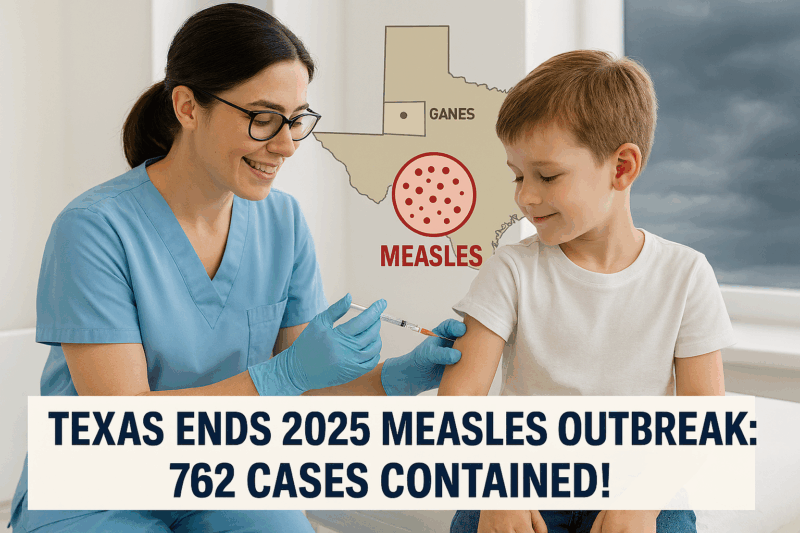On August 18, 2025, Texas officially declared the end of a significant measles outbreak that began in late January, centered in West Texas, particularly Gaines County. With no new cases reported for over 42 days—double the measles incubation period—the Texas Department of State Health Services (DSHS) confirmed the outbreak’s conclusion. However, ongoing global risks and low vaccination rates in some areas keep the threat alive. This article details the outbreak, its impacts, and connections to broader regional and global challenges, including Hurricane Erin and infrastructure incidents in North Carolina.
Details of the Texas Measles Outbreak
- Scope and Scale: The outbreak resulted in 762 confirmed cases across Texas, contributing to a national total of 1,356 cases as of August 5, 2025, per the Centers for Disease Control and Prevention (CDC). Gaines County reported 414 cases, making it the epicenter. The virus primarily affected school-aged children, with two-thirds of cases in this group.
- Health Impacts: Ninety-nine people were hospitalized, and two children died, highlighting measles’ severity. About one in five infected children required hospitalization, and one in 20 developed pneumonia, per DSHS. Rare complications included brain swelling and pregnancy issues.
- Response Efforts: DSHS Commissioner Jennifer A. Shuford praised the “tireless work” of public health professionals, who conducted extensive testing, vaccination drives, disease monitoring, and awareness campaigns. Healthcare providers, many unfamiliar with measles due to its rarity, played a critical role in identifying and treating cases.
- Vaccination Push: The DSHS emphasized that two doses of the MMR (measles, mumps, rubella) vaccine are the best prevention, noting measles’ high contagiousness—one infected person can spread it to 10–15 others.
Ongoing Risks and Recommendations
- Persistent Threat: Despite the outbreak’s end, measles remains a global concern, with active cases in North America and beyond. The DSHS urged healthcare providers to stay vigilant, testing patients with symptoms like fever, rash, cough, or conjunctivitis. Unvaccinated individuals face the highest risk, with Texas reporting a 9% exemption rate for school vaccinations in 2024, per the CDC.
- Public Health Measures: Experts like Dr. John Whyte recommend masks in high-risk areas, frequent handwashing, and surface cleaning, as measles can linger on surfaces. The DSHS advises maintaining vaccination schedules, particularly for children and travelers.
- Global Context: Measles outbreaks in 2025, including 1,200 cases in Canada and 900 in Mexico, per WHO data, highlight the need for international coordination. Low vaccination rates in some U.S. communities, driven by misinformation, exacerbate risks.
Broader Context and Regional Connections
- Hurricane Erin’s Impact: As reported by Newsweek, Hurricane Erin, a Category 2 storm on August 20, 2025, threatens North Carolina’s Outer Banks with tropical storm conditions, high waves, and rip currents. This could strain public health resources, as coastal evacuations and flooding may disrupt vaccination clinics or disease monitoring, increasing measles risks in affected areas.
- Wilmington Explosion: The August 19 explosion at a Wilmington, North Carolina, veterinary center, caused by a hit-and-run driver rupturing a gas line, injured four firefighters and damaged infrastructure. This incident, combined with Erin’s approach, highlights the region’s vulnerability to simultaneous crises, potentially diverting resources from health surveillance needed to prevent measles resurgence.
- Climate and Infrastructure Parallels: The Texas measles outbreak, driven by human factors like vaccine hesitancy, mirrors Spain’s 2025 wildfires, exacerbated by arson and climate change, as noted in Newsweek. Both crises underscore the interplay of human behavior and environmental factors in amplifying public safety challenges.
Official and Community Reactions
- DSHS Commissioner Jennifer Shuford: Highlighted the success of coordinated efforts, stating, “We contained one of the most contagious viruses through comprehensive response.” She urged continued vigilance due to global risks.
- Community Sentiment: On X, posts like @TexasHealth praised the state’s response but warned of anti-vaccine misinformation. Others expressed relief, with @LubbockMom noting, “Thankful our kids are safe, but we need to keep vaccinating.”
- Healthcare Providers: The DSHS recognized providers’ efforts in tackling a virus many had never seen, emphasizing the importance of training for rare diseases.
Key Statistics
| Metric | Details |
|---|---|
| Texas Cases | 762 confirmed, centered in Gaines County (414 cases) |
| U.S. Cases | 1,356 as of August 5, 2025 (CDC) |
| Hospitalizations | 99, primarily school-aged children |
| Deaths | 2 children |
| Vaccination Rate | 91% in Texas schools, 9% exemption rate (2024) |
Conclusion
Texas’ successful containment of the 2025 measles outbreak, with 762 cases and no new infections for 42 days, marks a public health victory, driven by robust vaccination and response efforts. However, global risks and regional challenges, like Hurricane Erin’s threat to North Carolina and Wilmington’s recent explosion, underscore the need for sustained vigilance. Vaccination remains critical to prevent future outbreaks. Share your thoughts on improving public health preparedness in the comments, and follow us for updates on health and regional crises.





